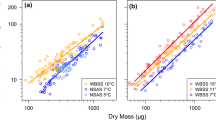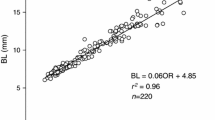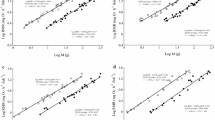Summary
Energy budgets of juvenile pike and perch (weighing approximately 3 g) were determined in experiments lasting up to 4 days, by simultaneously measuring oxygen consumption, food consumption, and growth of individual fish. Although the basic pattern of energy allocation was identical in the two species, perch subjected to constant light (PEL) showed faster growth, higher assimilation and conversion efficiency, and higher oxygen consumption than perch subjected to a short daylength regime (PED). The efficiency with which food energy was converted into body mass was 39±5% in PED but 49±4% in PEL. However, the “work coefficient” (increment of body mass/post-prandial increase of oxygen consumption: mg · μmol O sup−1inf2 ) differed only insignificantly between the two groups of perch, indicating that the metabolic cost of growth was unaffected by the manipulation of experimental conditions. This identifies the higher assimilation efficiency, i.e. the increased flow of food energy into the tissues as being the cause of accelerated growth of perch under the constant-light regime. In both species the maximum feeding-induced metabolic rate was 4 times higher than the lowest preprandial rate. In perch (which were kept on low rations before the experiments) the post-prandial metabolic rate increased steadily from day to day during the 4-day experiments, so that on the last day the rate of oxygen consumption exceeded the rate on the first day by about 41%. This investigation provides further evidence that the allocation of metabolic energy in fish is based on a flexible strategy which responds sensitively to changes in both internal and external conditions.
Similar content being viewed by others
References
Adolph EF (1983) Uptakes and uses of oxygen, from gametes to maturity: an overview. Resp Physiol 53:135–160
Brett JR (1979) Environmental factors and growth. In: Hoar WS, Randall DJ, Brett JR (eds) Fish Physiology 8. Academic Press, New York, pp. 599–677
Brett JR, Groves TDD (1979) Physiological energetics. In: Hoar WS, Randall DJ, Brett JR (eds) Fish Physiology 8. Academic Press, New York, pp. 279–352
Calow P (1989) Are individual production rates optimized by natural selection? In: Wieser W, Gnaiger E (eds) Energy transformations in cells and organisms. Thieme Verlag, Stuttgart, pp. 264–269
Calow P, Townsend CR (1981) Resource utilization in growth. In: Townsend CR, Calow P (eds) Physiological Ecology. Blackwell Scientific Publications, Oxford, pp. 220–244
Diana JS (1983) An energy budget for northern pike (Esox lucius). Can Zool 61:1968–1975
Eriksson L-O (1978) A laboratory study of diel and annual activity rhythms and vertical distribution in the perch,Perca fluviatilis, at the Arctic circle. Env Biol Fish 3:301–307
Forstner H, Wieser W (1990) Patterns of routine swimming and metabolic rate in juvenile cyprinids at three temperatures: analysis with a respirometer-activity-monitoring system. J Comp Physiol B 160:71–76
Fry FEJ (1947) Effects of the environment on animal activity. Univ Toronto Stud Biol Ser 55:1–62
Fry FEJ (1971) The effect of environmental factors on the physiology of fish. In: Hoar WS, Randall DH (eds) Fish Physiology 6. Academic Press, New York, pp. 1–99
Gross WL, Roelofs EW, Fromm PO (1965) Influence of photoperiod on growth of green sunfish,Lepomis cyanellus. J Fish Res Bd Can 22:1379–1386
Ivlev VS (1945) ‘Biologicheskaya produktivnost’ vodoemov. Usp Sovrem Biol 19:98–120 English translation: The biological productivity of waters. J Fish Res Bd Can 23:1727–1759
Jobling M (1981) The influences of feeding on the metabolic rate of fishes: a short review. J Fish Biol 18:385–400
Johnson L (1966) Experimental determination of food consumption of pike,Esox lucius, for growth and maintenance. J Fish Res Bd Canada 23:1495–1505
Kirkwood TBL (1987) Maintenance and repair processes in relation to senescence: adaptive strategies of neglect. In: Calow P (ed) Evolutionary physiological ecology. Cambridge University Press, Cambridge, pp. 53–66
Koch F, Wieser W (1983) Partitioning of energy in fish: can reduction of swimming activity compensate for the cost of production? J Exp Biol 107:141–146
Parsons PA (1990) The metabolic cost of multiple environmental stresses: implications for climatic change. Trends Ecol Evol 5:315–317
Persson L (1979) The effects of temperature and different food organisms on the rate of gastric evacuation in perch (Perca fluviatilis). Freshw Biol 9:99–104
Scholz C (1932) Experimentelle Untersuchungen über die Nahrungsverwertung des ein- und zweisömmerigen Hechtes. Z Fisch 30:4–14
Sibly RM, Calow P (1986) Physiological ecology of animals. An evolutionary approach. Blackwell Scientific Publications, Oxford
Sibly RM, Calow P (1989) A life-cycle theory of response to stress. Biol J Linn Soc 37:101–116
Siegmund R (1969) Lokomotorische Aktivität und Ruheverhalten bei einheimischen Süßwasserfischen (Pisces; Percidae, Cyprinidae). Biol Zentralbl 88:295–312
Solomon DJ, Brafield AE (1972) The energetics of feeding, metabolism and growth of perch (Perca fluviatilis L.) J Anim Ecol 41:699–718
Soofiani NM, Hawkins AD (1982) Energetic cost at different levels of feeding in juvenile cod,Gadus morhua L. J Fish Biol 21:577–592
Waterlow C, Milward DJ (1989) Energy cost of turnover of protein and other cellular constituents. In: Wieser W, Gnaiger E (eds) Energy transformations in cells and organisms. Thieme Verlag, Stuttgart, pp. 277–282
Wieser W, Medgyesy N (1990a) Aerobic maximum for growth in the larvae and juveniles of a cyprinid fish,Rutilus rutilus (L.): implications for energy budgeting in small poikilotherms. Funct Ecol 4:233–242
Wieser W, Medgyesy N (1990b) Cost and efficiency of growth in the larvae of two species of fish with widely differing metabolic rates. Proc R Soc Lond B 242:51–56
Wieser W, Forstner H, Medgyesy N, Hinterleitner S (1988a) To switch or not to switch: partitioning of energy between growth and activity in larval cyprinids (Cyprinidae: Teleostei). Funct Ecol 2:499–507
Wieser W, Forstner H, Schiemer F, Mark W (1988b) Growth rates and growth efficiencies in larvae and juveniles ofRutilus rutilus (L.) and other cyprinid species: effects of temperature and food in the laboratory and in the field. Can J Fish Aqu Sci 45:943–950
Wieser W, Krumschnabel G, Ojwang-Okwor JP (1991) The energetics of starvation and growth after refeeding in juveniles of three cyprinid species. Env Biol Fish (in press)
Author information
Authors and Affiliations
Rights and permissions
About this article
Cite this article
Wieser, W., Medgyesy, N. Metabolic rate and cost of growth in juvenile pike (Esox lucius L.) and perch (Perca fluviatilis L.): the use of energy budgets as indicators of environmental change. Oecologia 87, 500–505 (1991). https://doi.org/10.1007/BF00320412
Received:
Accepted:
Issue Date:
DOI: https://doi.org/10.1007/BF00320412




